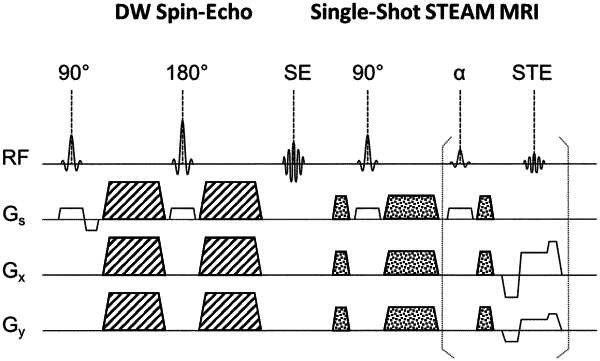| CPC G01R 33/56341 (2013.01) [G01R 33/4824 (2013.01); G01R 33/5608 (2013.01); G06T 5/20 (2013.01); G06T 5/77 (2024.01); G06T 11/008 (2013.01); G06T 2207/10088 (2013.01)] | 11 Claims |

|
1. A method for creating multiple sequences of diffusion-weighted magnetic resonance images of an object under investigation, wherein each of said sequences of magnetic resonance images represents a same series of contiguous cross-sectional slices covering a volume of the object under investigation, comprising the steps of:
(a) providing multiple sequences of sets of image raw data being collected using at least one radiofrequency receiver coil of a magnetic resonance imaging device, wherein
each set of image raw data includes an image content of one of the magnetic resonance images to be reconstructed,
each set of image raw data refers to one of the contiguous cross-sectional slices,
each set of image raw data includes a plurality of data samples being generated with a combined diffusion-weighted spin-echo and single-shot stimulated-echo sequence with diffusion-encoding gradients, said combined sequence spatially encoding a magnetic resonance imaging signal received with the at least one radiofrequency receiver coil using a non-Cartesian k-space trajectory,
said diffusion-encoding gradients of said multiple sequences of sets of image raw data having at least two different strengths and at least three different directions, wherein one of the sequences of sets of raw data is generated with diffusion-encoding gradients of zero strength or lower strength and further sequences of sets of raw data are generated with diffusion-encoding gradients of higher strength,
each set of image raw data comprises a set of homogeneously distributed lines in k-space with equivalent spatial frequency content,
the lines of each set of image raw data cross a center of k-space and cover a continuous range of spatial frequencies,
a number of lines of each set of image raw data is selected such that each set of image raw data is undersampled below a sampling rate limit defined by the Nyquist-Shannon sampling theorem, and
positions of the lines of each set of image raw data differ in sets of image raw data from neighboring cross-sectional slices,
(b) subjecting a sequence of sets of image raw data generated with diffusion-encoding gradients of zero strength or lower strength to a regularized nonlinear inverse reconstruction process to provide a sequence of coil sensitivities and magnetic resonance images with no or lower diffusion weighting, each of the magnetic resonance images representing one of the cross-sectional slices and being created by a simultaneous estimation of a sensitivity of the at least one receiver coil and the image content and in dependency on a difference between a current estimation of the sensitivity of the at least one receiver coil and the image content and an estimation of the sensitivity of the at least one receiver coil and the image content of a neighboring cross-sectional slice, and
(c) subjecting all sequences of sets of image raw data with diffusion-encoding gradients of zero or lower strength as well as of higher strength to a regularized linear inverse reconstruction process, to provide a sequence of magnetic resonance images with no or lower diffusion weighting and a sequence of magnetic resonance images with higher strength each of the magnetic resonance images representing one of the cross-sectional slices and being created by using the sensitivity of the at least one receiver coil determined in step (b) for the same cross-sectional slice and in dependency on a difference between a current estimation of the image content and an estimation of the image content of a neighboring cross-sectional slice.
|